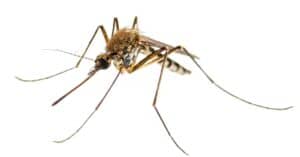Using an intricate system involving needles and spit, mosquitoes are professionals at stealing blood. However, they’re not doing it for the reasons you might think!
Follow along as we uncover why mosquitoes are so eager to drink your blood. We’ll also address some common mosquito-related questions, such as why they seem to target you more than your friends and how to stop bites from itching. Read on to explore why mosquitoes suck your blood.
Why Do Mosquitoes Suck Your Blood?
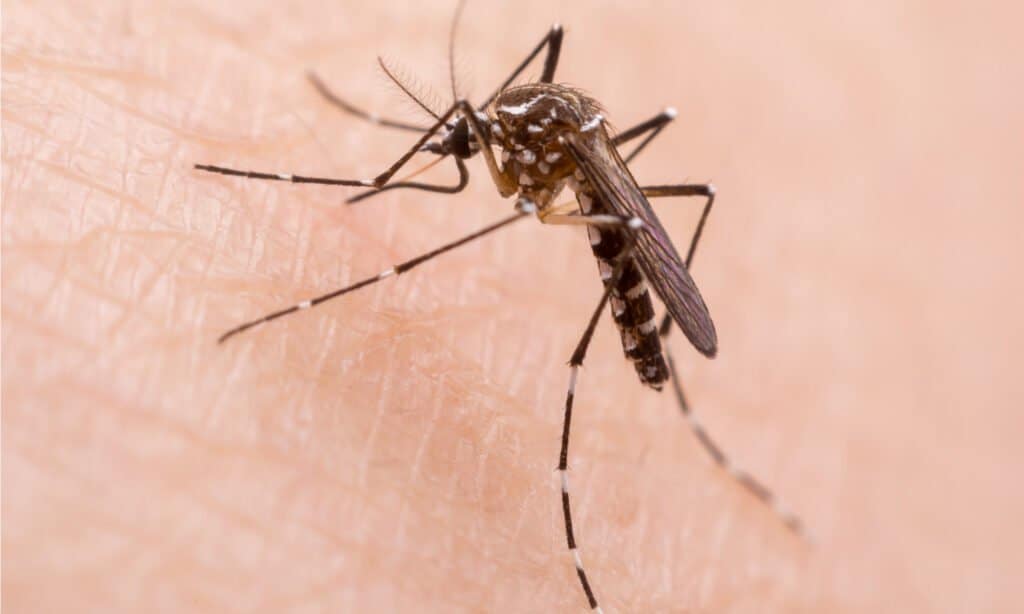
Female mosquitoes suck your blood to help develop their eggs, of which they can lay over 100 at a time.
©Surachai Pung/Shutterstock.com
Mosquitoes suck your blood to make their eggs. Your blood cells are rich in things like iron, proteins, and amino acids, all of which help with egg development. Drinking blood is something only female mosquitoes do. After they finish collecting your blood, female mosquitoes look for a good place to lay their eggs, usually near water, soil, or plants. Females are generally larger than male mosquitoes and can lay 100 or more eggs at once.
Balancing Nutrient and Toxicity
Too much iron can be toxic. So, how does a tiny mosquito handle filling up its body with iron-rich blood? To prevent iron overload, mosquito cells employ a unique method to manage their iron levels, which begins even before they hatch. When mosquito larval cells encounter iron, they generate and release a substance known as ferritin to regulate iron levels. When iron is scarce, ferritin levels increase, and when iron is abundant, ferritin levels decrease.
How Your Blood Fuels the Mosquito Lifecycle
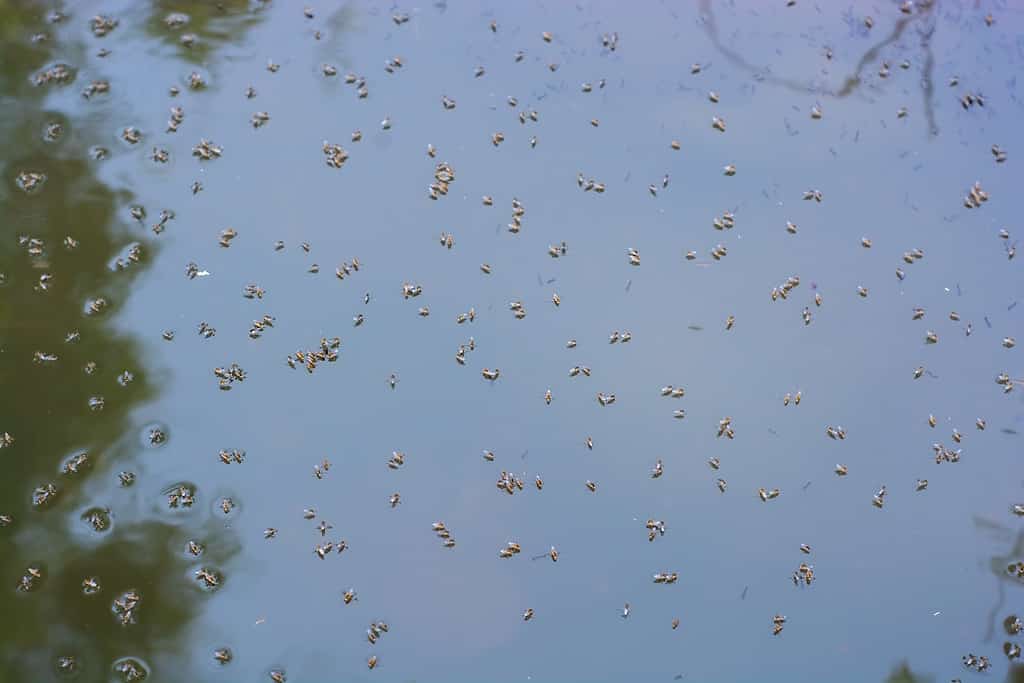
The surface of the water is the perfect breeding site for newly emerged adult mosquitoes.
©Hussain Warraich/Shutterstock.com
The mosquito life cycle consists of four stages: egg, larva, pupa, and adult. Males tend to live a short 5-6 days, while females can stick around for several weeks, with some living up to 5 months, although the average female lifespan is around 5-6 weeks.
Egg-Laying
After a female mosquito bites you, she’s on a mission to find a good spot to lay her eggs. She prefers places near water, but it doesn’t have to be a big lake—buckets, bird baths, old tires, or even rain-filled gutters work just fine. A female mosquito can lay 100 or more tiny eggs at once, which look like little specks of dirt. These eggs are pretty tough and can survive without water for about 8 months. Once a little bit of water covers the eggs, they hatch, starting the next stage of the mosquito’s life.
The Larva Stage
Baby mosquitoes, also known as larvae or “wrigglers,” are harmless to humans. They don’t feast on us; instead, they dine on tiny creatures living at the water’s surface. When they sense danger, they swim in a funny wiggly shape, like making an “S,” which is why they get the nickname “wriggles.”
Larvae have a busy stage of the lifecycle and undergo several molts. The periods between these molts are referred to as “instars”, and it’s common for there to be four of them. Under optimal conditions, they can progress to the pupal stage in as little as 5 days. However, factors such as food availability and water temperature can extend the larval stage to as long as 14 days.
Pupae and Transformation
Pupae, also known as “tumblers,” do not feed. These minuscule shrimp-like creatures are sensitive to light and shadows. They can move actively to shift to a safer position if they sense danger. Within 2-3 days, they transform into adult flying mosquitoes. This transformation occurs when the pupal skin splits along the back, allowing the mosquito to emerge as an adult.
Adult Mosquitoes
Newly emerged adults aren’t ready to fly right away. They need some time to harden their body parts and make sure their wings dry out properly. During this waiting period, they rest on the surface of the water, where they were once pupae. As soon as they’re able, the new adult males immediately begin a mission to find a mate. They stay on the surface of the water after emerging, listening and waiting for the new females to show up.
How Do Mosquitoes Suck Your Blood?
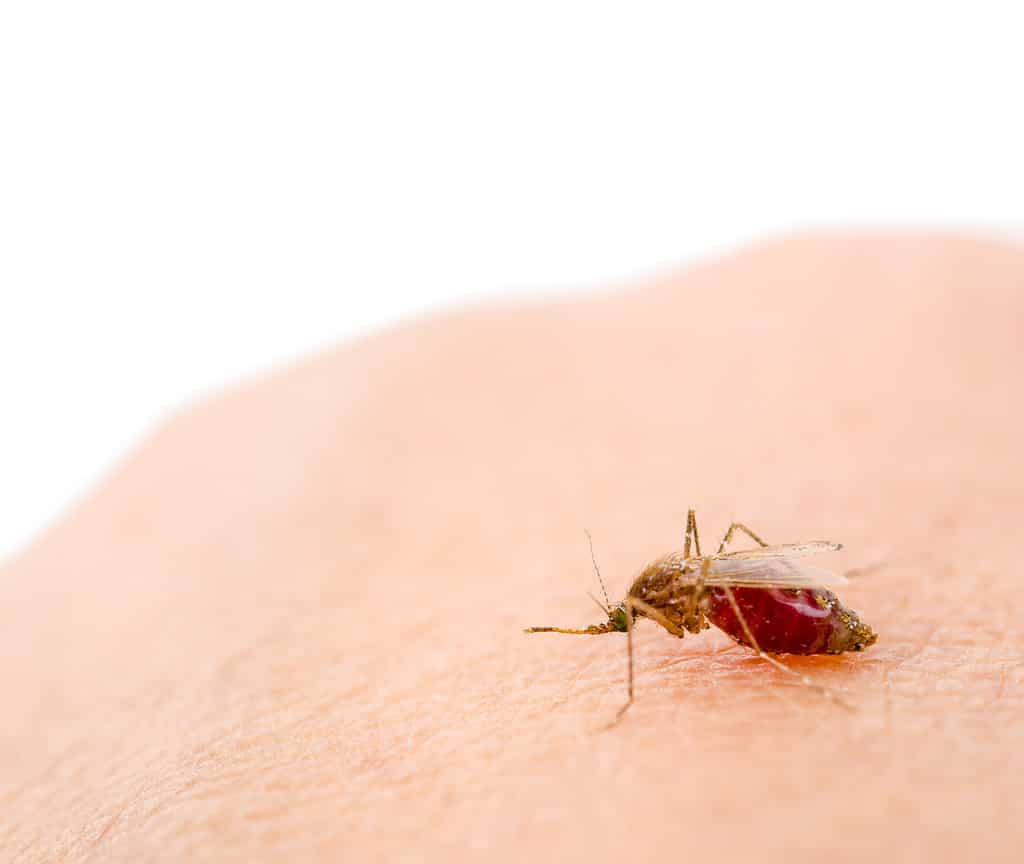
A mosquito’s mouth has six needles that work together to hold your skin in place and suck your blood.
©Gam1983/ via Getty Images
Mosquitoes are needle ninjas, wielding not one, not two, but six needles to feed on your blood. This intricate process involves two needles that gently hold your skin apart, while another two delicately saw through the skin’s surface near the targeted vein. The fifth needle’s role is to suck up the blood, while the sixth assists the mosquito in tasks, such as producing saliva.
Mosquito Mouths
Thankfully, mosquitoes don’t have or need teeth. In terms of their mouthparts, mosquitoes possess what is called a proboscis. Both female and male mosquitoes use their mouths to drink plant nectar and other sugar sources. This upside-down-looking funnel has more than 150 proteins known as receptors. The receptors are the mosquito’s secret weapon for food sources. And for females, the receptors also help them detect nutrient-rich water sources for laying eggs.
Why Do Mosquitoes Bite You More Than Other People?
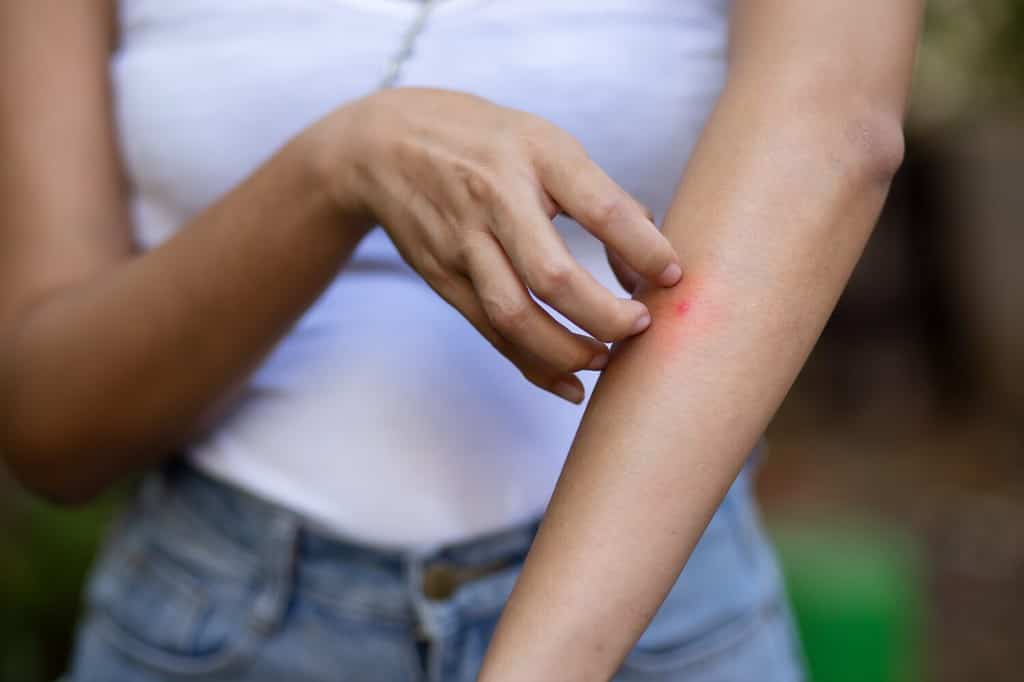
Certain body odors attract mosquitoes, while other ones help deter them.
©9nong/Shutterstock.com
You’re not imagining it. Mosquitoes are biting you more than you’re friends. But it’s not that they like your blood more. It’s just because you’re easy to find, and that’s because, in the language of bugs, you smell awesome.
Some people emit body odors that scream “all-you-can-eat mosquito buffet”. This makes them an easy target for mosquito bites. On the flip side, according to Rothamsted Research in the UK, some fortunate individuals seem to be off the mosquitoes’ radar completely. This is because their body odors contain substances that mosquitoes find unappealing.
When someone emits enough of these repellent odors, it essentially hides them from mosquitoes. Since mosquitoes rely on scent to locate their prey, if they can’t detect those inviting scents, they can’t find their next meal.
Where Mosquitoes Hangout
Where you live can also make you a more likely candidate for bites. Several states in the United States have the perfect setup for mosquito infestations. Take for instance wet, swampy Florida leading the list with over 80 mosquito species. Texas closely follows with more than 80 species as well, while Louisiana, Georgia, North Carolina, Alabama, and Oklahoma have between 60 and 68 mosquito species each. These bugs love setting up camp in ponds, marshes, swamps, and lakes.
The Trick to Stopping Mosquitoes From Biting You
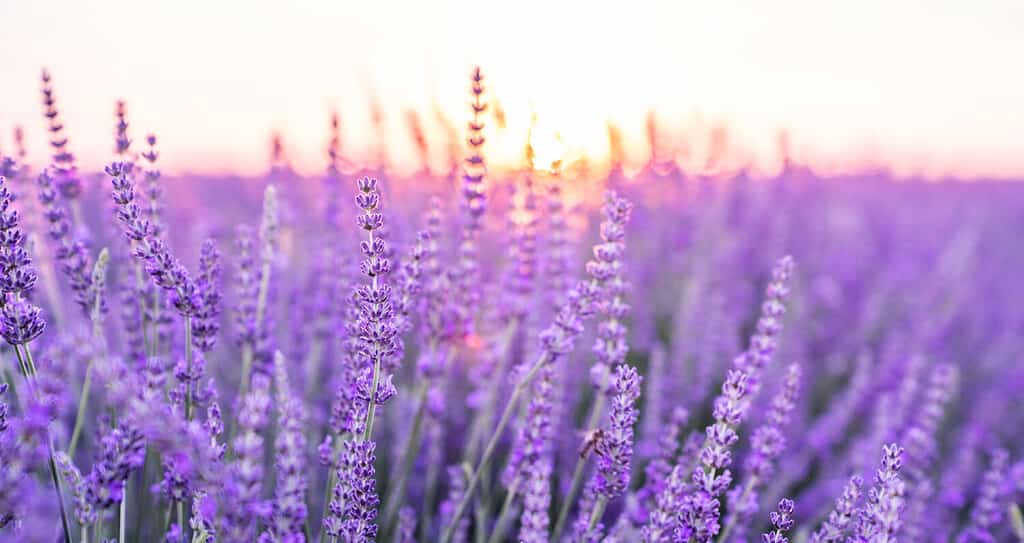
Use essential oils like lavender to send mosquitoes flying in the other direction.
©ESstock/Shutterstock.com
Stay mosquito-free with these strategies! First on the list, is DIY mosquito repellant. If you love all things essential oils, then you’ll love making your very own bug spray. It’ll smell incredible to you, and horrible to the bugs.
To get started, consider citronella, lemongrass, and lavender as your go-to ingredients for crafting fast-acting natural repellents. These scents can be seamlessly integrated into DIY mosquito sprays or used in diffusers to create an aromatic shield.
If you’re looking for a more hardy natural solution, turn to the power of eucalyptus, known for its potent scent and mosquito-repelling properties. Mix 1/3 cup water with 35-40 drops of eucalyptus essential oil. Add in 1/3 cup witch hazel, and you’ll have a potent homemade repellant.
Need something stronger? Developed by the U.S. Army in 1946, DEET remains one of the most potent mosquito repellents. Be sure to read the directions and follow them closely. Be cautious with prolonged use, as it can lead to health issues like breathing problems, headaches, and more.
Mosquito Proof Your Yard
Mosquitoes strongly dislike certain smells, like cedar, so adding cedar mulch around your plants and house is a smart move. You can also rely on the aesthetic appeal of geraniums and marigolds to keep those mosquitoes away. Marigolds offer a vibrant range of colors, including yellow, orange, red, and white, while geraniums boast various color combinations. For an elegant yet effective repellant, consider hanging geranium baskets on your front porch. They’re lemon-like scent not only keeps mosquitoes at bay, but other pests too!
Unmasking the Discomfort: Why Bites Itch So Much
Why do mosquito bites itch so much? It has to do with insect spit and your body’s built-in survival system.
When mosquitoes suck your blood, they inject saliva. The saliva, being a foreign substance, triggers an immunity response, causing your body to send out histamines. These histamines can increase blood flow, and cause your nerves to itch. The immune response can also cause the famous mosquito bite bump.
Little pink bumps are usually visible within 20 minutes, but some take as long as 24 hours to experience peak itchiness. For some, the bumps are much bigger than others. While some individuals have a mild reaction to mosquito bites, others react strongly, experiencing a large area of swelling, soreness, and redness.
How to Stop the Itch
How can you soothe the maddening itch of a mosquito bite? Find relief by using ice packs, hydrocortisone cream, calamine lotion, a homemade baking soda paste, or even aloe vera.
Ice Pack
To ease the swelling and itchiness, try applying an ice pack to those little pink bumps. Keep the ice pack on the bites for about 10-15 minutes, then give your skin a breather. If the itching returns, you can always reapply the ice pack later.
Hydrocortisone or Calamine Lotion
You can also reach for an over-the-counter anti-itch cream like hydrocortisone or calamine lotion. Read the directions before applying and always wait the allotted time before rinsing off your skin. For multiple bites or intensely itchy ones, you may need to apply the lotion frequently throughout the day. Typically, apply it to the affected area up to 3 to 4 times daily or as instructed by your doctor.
How do these creams stop the itch? Hydrocortisone is all about reducing pain and inflammation with its steroid properties. The cream lets your body know it can relax, which helps slow down the intense immune response. Additionally, calamine lotion, famous for its pink color, blends zinc oxide for skin protection and soothing qualities.
Baking Soda Paste
For a DIY option, make your own soothing paste using baking soda. Just mix one tablespoon of baking soda with a bit of water to create a paste, apply it to the bite, and leave it on for around 10 minutes before gently rinsing it off.
Aloe Vera
Aloe vera is more than just a sunburn remedy; it can also ease the discomfort of mosquito bites. This plant boasts natural anti-inflammatory properties, making it highly effective at reducing itching and swelling caused by bug bites. Pro tip — keep your aloe vera gel in the fridge. The cooling effect amplifies its effectiveness, providing even more relief.
Don’t Scratch
Just remember, no matter how much they itch, resist the urge to scratch. Scratching can be counterproductive and might even lead to infections.
Will Giant Mosquitoes Suck Your Blood?
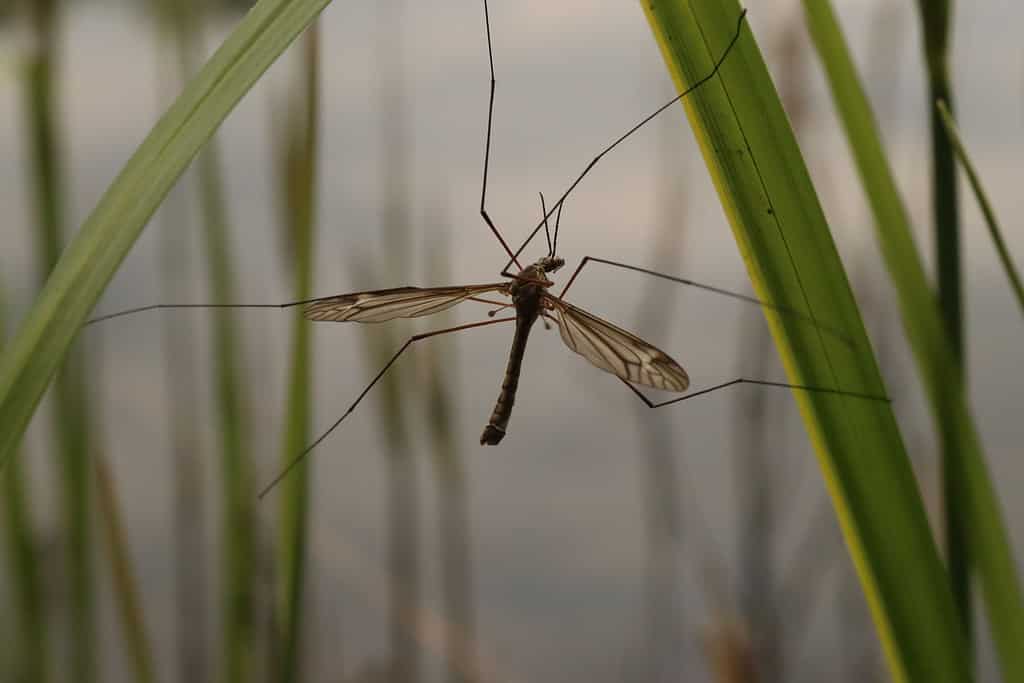
Crane flies look like giant mosquitoes, but they’re completely harmless to humans.
©Wirestock/iStock via Getty Images
Giant mosquitoes aren’t mosquitoes at all; they’re crane flies. To tell them apart, remember this rule: if it’s bigger than a dime, it’s probably a crane fly. Adult crane flies can vary in size depending on the species, but typically, they measure up to about 1½ inches and have six long, stilt-like legs.
Despite their size and odd looks, crane flies are completely harmless to humans. They’re even harmless to mosquitoes.
You might have heard crane flies being called “mosquito hawks” or “skeeter-eaters,”. This is because many people mistakenly believe they’re mosquito predators. But these big flies don’t care much about food at all. Most adult crane flies never eat.
Identifying Different Mosquito Species
Did you know that there are over 3,500 species of mosquitoes worldwide? About 200 of the species can be found flying throughout the United States. With so many different kinds, how do the experts tell them apart?
Here are a few of the ways experts tell species apart from one another:
- Checking scales on the mosquito’s body
- Noting size, color, and any unique markings
- Observing flight pattern
- Studying feeding behaviors
- Examining distinctive markings, such as spots or stripes
Researchers can tell mosquito species apart by looking at their unique patterns and markings. For example, let’s take the permanent water mosquito, which has wide, straight golden-brown and yellow scales on both sides of its thorax.
Mosquitoes also have distinct leg markings. Consider the western tree-hole mosquito; its upper legs are all dark with white speckles, and it has light bands on its lower leg joints.
Feeding habits are another giveaway. Some species only eat at night, while others feast during the day. For instance, one nuisance species, Psorophora signipennis is a day-time biter. While a domestic species, Culex tarsalis, is a night-time biter, becoming active at dusk and continuing until dawn.
The photo featured at the top of this post is © CDC/James Gathany/CC0 1.0 – License / Original
Thank you for reading! Have some feedback for us? Contact the AZ Animals editorial team.




